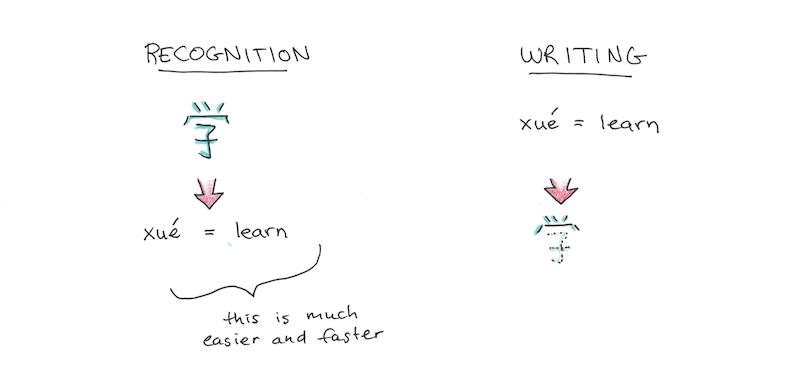I’ve been learning Chinese now for roughly five years. Including a burst of intensive immersion during three months in China near the beginning, plus plenty of practice since, I now feel fairly comfortable with the language.
I’m still a long way from perfect fluency, but I’m at a point where conversing in Chinese is pretty easy, I can read novels without a dictionary and I’ve even done some impromptu speaking and media interviews while in China.
Learning Chinese has been one of the hardest subjects I’ve studied, but also one of the most rewarding. I find the language and culture endlessly fascinating, and I fully expect to spend my entire life learning it.
If you’re also interested in learning Chinese, I’d like to lay out some of the things that have helped me. I’d like to emphasize advice or ideas I wish I had heard when I started. I don’t intend this guide to be complete, perfect or authoritative. It’s just what I’ve done, and what has worked for me.
My Advice for Learning Chinese
1. Learn to Recognize (but Not Write) the Characters

My first starting point into Chinese (before I ever set foot in China) was to play around with a huge set of flashcards on Anki called Mastering Chinese Characters. These decks (split into 10) had thousands of cards and covered the most common characters.
Unfortunately, they were taken down from Anki’s website due to copyright issues a few years ago. If you google around for them, there are some still uploaded in different places, but since I think the content was ripped off some other platform, I don’t know if they have a stable home now.
These cards are imperfect (all resources are), but their main advantage is volume. There are so many cards that you can spend a few years with this resource.
When I started learning Chinese, I doubted whether doing all these flashcards was actually such a good idea. Flashcards featured minimally in learning Spanish, which had gone fairly well for me, and I had been coached into believing that learning to read/write at all is something that should happen a lot later into learning Chinese.
In retrospect, however, learning to recognize the characters was a huge advantage. Most words you’ll encounter are made up of the most common 2000 characters or so. Therefore, if you know these characters, you’ll immediately have hooks for mastering any new vocabulary.
This was especially useful for me when I started because I found it very difficult to memorize words by sound alone, especially when there are only differences due to tone. Having a huge glut of characters memorized meant that I could immediately form a mnemonic when I encountered a new word to remember it. (i.e. “Oh, so printer = ??? = (make) (mark/impression) (machine)”)
On the other hand, I don’t think learning to write the characters is necessarily worth the hassle. It takes a lot less effort to successfully recognize a character ~95%+ of the time in context, than it does to draw it without a reference. I think being able to know the basics of handwriting, including knowing how to draw ~100 components is probably sufficient for most purposes, since you’ll probably use pinyin entry for typing anyways.
My advice: Get a resource for learning the characters. Make character recognition, meaning and sound a part of your daily study in the beginning until most the characters you see are ones you recognize.
This can be done from the very first day, but may take a year or two to complete, depending on your intensity. It doesn’t need to precede other learning activities, but it will give a foundation that helps with everything else.
2. Practice the Tones (But Don’t Get Stuck on Them)

Tones were the aspect of speaking Chinese that mystified and intrigued me the most when I started. People talk, and by subtle inflections in their pronunciation, they could take one word and turn it into something completely different.
Intrigue, however, quickly turned to frustration as I recognized that I couldn’t hear the tones! I couldn’t tell when someone was saying first tones or third tones, second or fourth, unless they slowed their speech down to a few seconds per syllable.
Doubly-frustrating was that my own tones didn’t seem to work. I struggled intensely with differentiating ?? (hàny? = Chinese) and ?? (hány? = Korean), and many times I’d try to say something, people would hear something else.
While pronunciation is important, and so I think it is crucial to work on your pronunciation, in retrospect I let the tones worry me too much.
The problem of listening was mostly solved through increased exposure. Eventually you can start to hear tones in speech with better accuracy, and even start to catch people making tonal mistakes. Producing tones also got better, albeit more by mimicking how native speakers talk than by practicing elaborate tone drills.
From talking to Chinese learners, my sense is that many more get the q/ch, x/sh, j/zh confusions worse than the tonal errors. Even including all types of pronunciation errors apart from tones, vocabulary is still a far bigger problem for most speakers.
My advice: Learn the tones and pronunciation. Especially, learn the tongue positions for unusual sounds such as those in ‘q’, ‘x’, ‘j’, ‘ü’ and ‘r’. However, your focus should be on vocabulary acquisition since this is the biggest hurdle to communicating in Chinese.
3. Graded Readers + Pleco Document Reader are Your Friends.

I care about knowing how to read in Chinese. That’s not everyone’s goal, but it’s a big part of what I wanted to get from learning the language.
Unfortunately, reading Chinese is often an even more daunting task than learning to speak it. With thousands of characters, few pronunciation cues and vocabulary that differs from spoken Chinese, learning to read doesn’t come automatically after learning to speak the way it does in many other languages.
Doing the basic character mastery is an important first step. If you can recognize the characters in isolation with relatively high accuracy, you won’t necessarily know what words they form when linked together, but you’ll do far better than if every second character you see is a new one.
However, if you want to read, knowing characters isn’t enough. You actually have to read.
This too is hard because often native materials are waaay too hard for beginners, and there’s little else to practice with. Here two things helped me immensely: graded readers and, later, Pleco’s document reader.
Graded readers, which are texts written to use a more restricted vocabulary and character base, are good starting points because you can read through them more comfortably without having to look up every second word. I highly recommend the following graded reader series:
To really read things, though, you need to go a lot beyond just graded readers. This is why I recommend getting Pleco (the most popular Chinese-English dictionary) and buying the Document Reader add-on. This reader allows you to open files and by tapping on words which are unfamiliar, Pleco will automatically translate it for you. This saves an enormous amount of time from trying to copy the character and paste it (or worse, trying to handwrite each one you don’t know to look up a definition).

I used this with smaller documents and short-stories, before reading my first full-length novel Liu Cixin’s ???? (The Three Body Problem) entirely within Pleco. From it, I could easily look up many terms that were unfamiliar and I didn’t need to waste much time.
My advice: Start with character practice. Then graded readers. When you’re bored with those, go onto reading native material with Pleco’s document reader.
4. Immersion Helps a Lot, But Get Some Practice in First.

Going to China early on and spending it in near-complete immersion was a huge benefit to learning Chinese. Not only does immersion give ample practice opportunity, but it connects learning to real life, providing you with motivation to improve your skills.
However, I found Chinese hard enough that even basic things were quite difficult until I had built the proper foundation. I had spent about ~100 hours practicing before going to China, and that felt like roughly the right amount of time to really dive in. My friend who traveled with me did less than that, and I think he struggled a lot more with learning things.
I would recommend putting in 100-250 hours of practice before going for an extended stay in China. I suggest this for two reasons:
- You’ll want to go for immersion on Day 1. This is because otherwise an English bubble will form around you which will be hard to break out of. The more prep you have, the easier this is to do.
- Getting the foundation is going to make everything you encounter while abroad much easier to remember. Therefore, I think learning efficiency increases with more foundation.
You don’t need to do super intensive practice. Most of my hundred hours were spent doing the flashcards to get a passing familiarity with the characters. If you can do something similar, along with knowing the basic grammar, pronunciation and a few dozen core phrases, you’ll be fine.
My advice: Put in 100-200 hours of practice before your first immersive trip. When you do go–make sure you set strict rules for yourself about when you can speak English, so you don’t get trapped in an English-speaking bubble!
5. Don’t Listen to the Whiners.

Chinese is hard. Tones are hard. Characters are hard. The culture is different and sometimes challenging. But it’s one thing to admit difficulty and another to give into complaining and griping.
I don’t know why, but China attracts a certain kind of masochistic element, of people who live in the country and complain about it constantly. Especially about how hard the language is, and why it’s impossible to really learn Chinese or all the obstacles that make learning it so hard.
This is a terrible attitude to have and totally counterproductive. Having reached a level in Chinese where I feel pretty good now, I can say that, no matter what difficulties you seem to be facing, they will go away with more practice.
- Can’t remember the characters? More practice and they’ll be perfectly memorized.
- Can’t hear tones? More practice and you’ll spot them immediately.
- Can’t get people to understand you? A larger foundation and people will understand you just fine, accent and all.
- Find the culture difficult to integrate into? More practice and you’ll be able to slide into situations more and more easily.
Chinese is hard, yes. But practice will resolve all problems.
My advice: Even if it feels like you’ve put in enormous effort and haven’t reached a level you’d like, have faith that more practice will lead to results. Learning Chinese is more endurance than speed.
6. More and Worse is Better.

I often try to talk about efficiency in learning. Isolating which methods are better for memory and for study. With Chinese, however, the problem is overwhelmingly one of insufficient volume of practice.
If you’re new to the language, you’re almost certainly not spending enough time with it. Anything you can do to increase the time you spend speaking, reading, listening or writing is beneficial, even if the quality of your practice doesn’t reach some magical ideal.
This is why I tend to like resources that are flawed, but massive, over those that are perfect but small. ChinesePod continues to be an excellent resource, not because they have discovered some kind of magical pedagogy, but because they have so many podcasts at early levels, that if you just stick to listening them all the time, you’ll learn some Chinese.
Similarly, the Mastering Chinese Character decks have some major flaws. The sentences used are overly formal and not how real people speak. They (stupidly) have a whole set of cards that ask you to name the character based on pronunciation, even though this is a one-to-many mapping, and thus can’t be done in flashcards. Yet, even with these flaws, they cover thousands of characters instead of dozens, and so can keep you occupied for awhile.
If you think about studying Chinese as a volume problem, rather than an efficiency problem, you can change your approach to increasing exposure. How could you make it easier to use the language more and more?
My advice: Always ask yourself how you can do more practice, rather than just “better” practice. As long as you engage in real use at least some of the time, the main goal should be to increase your daily practice.
7. Watch Shows You Already Know, Dubbed in Chinese
Watching movies and television are a real challenge with any new language, Chinese included. A good technique I found for learning other languages was to watch shows I had already seen in English, dubbed into a new language. I watched most of Star Trek: The Next Generation, in Spanish for this reason—I could follow the plot perfectly, even if I missed pieces of the dialog.
This is hard in Chinese. The reason is that few shows are dubbed into Chinese, with most people preferring subtitles instead. Subtitles don’t help much, because you’ll just ignore them to listen to the English.
One exception to this rule is children’s shows. So I was able to rewatch a lot of Dragonball Z (a show I saw as a kid) since these were actually dubbed, as opposed to just subtitled into Chinese.
This is another good way to increase your volume. Watching shows you’ve already seen before helps you stay on the plot while picking up new vocabulary. Once you feel more comfortable, you can watch more new shows, dramas and movies.
My advice: Watching shows you’ve already watched in English (or another language) dubbed in Chinese can be a good bridge to listening to actual television or movies without subtitles. Children’s shows tend to be the easiest to find dubbed versions.
8. Keep at It!

Learning Chinese is a lesson in patience. Thousands of unique characters. Tens (possibly hundreds) of thousands of words. Heck, you’ll also need to re-learn words for nearly every proper noun–every city, famous person or corporate brand has their own Chinese name!
At times, this volume of learning can feel overwhelming. How can you possibly learn all of that?
And yet, if you keep practicing, you learn more and more. Eventually, you find yourself encountering even fairly obscure things enough times to have them memorized. Things that felt overwhelming eventually become comfortable.
I had a conversation with Olle Ligne, who runs Hacking Chinese, a popular blog about learning Chinese. I told him (a few years ago) that I felt like I had gotten out of the beginner phase of learning, and now learning felt like a long intermediate slog, slowly piecing together the thousands of puzzle pieces that is Mandarin Chinese.
Olle’s reply to me was that this phase never ends. There’s always more to learn. Always things you haven’t discovered yet. But even if putting the pieces together takes time, puzzles are fun and this one creates a fascinating picture!

 I'm a Wall Street Journal bestselling author, podcast host, computer programmer and an avid reader. Since 2006, I've published weekly essays on this website to help people like you learn and think better. My work has been featured in The New York Times, BBC, TEDx, Pocket, Business Insider and more. I don't promise I have all the answers, just a place to start.
I'm a Wall Street Journal bestselling author, podcast host, computer programmer and an avid reader. Since 2006, I've published weekly essays on this website to help people like you learn and think better. My work has been featured in The New York Times, BBC, TEDx, Pocket, Business Insider and more. I don't promise I have all the answers, just a place to start.